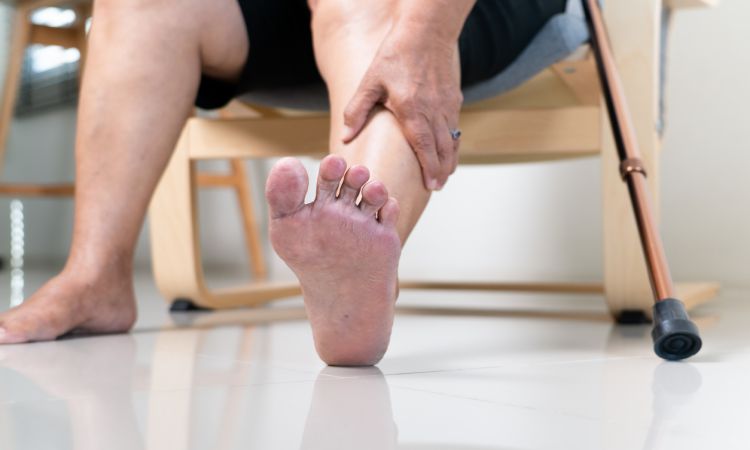 People with diabetes may develop wounds on their feet called diabetic foot ulcers. They are a frequent side effect of diabetes, and if untreated, can pose a major health risk. Diabetic foot care can help prevent the development of diabetic foot ulcers. Here are the risk factors for developing diabetic foot ulcers:
People with diabetes may develop wounds on their feet called diabetic foot ulcers. They are a frequent side effect of diabetes, and if untreated, can pose a major health risk. Diabetic foot care can help prevent the development of diabetic foot ulcers. Here are the risk factors for developing diabetic foot ulcers:
Poor Circulation
When the blood supply to your feet is limited, the cells in your feet may not receive the nutrients and oxygen they need to stay healthy. This can weaken skin and tissue, making it easier for bacteria and fungi to enter and cause infection.
If an infection is not treated promptly, an ulcer can form. Get regular checkups with your doctor or healthcare provider to keep your feet healthy and to access diabetic foot care tips. They can measure your pulse and check for any signs of poor circulation.
Foot Deformities
Diabetic people can be more prone to developing foot deformities such as bunions, hammer toes, and Charcot arthropathy. This is because of the changes in the foot’s structure and the disruption of the standard weight-bearing patterns. These foot deformities can cause pressure points on the skin that are vulnerable to breakdown and ulcer formation.
Peripheral Artery Disease
Peripheral Artery Disease (PAD) is a common complication of diabetes. PAD occurs when the blood vessels that carry blood to the lower extremities become narrowed or blocked, reducing the flow of oxygen and nutrients to the feet.
This can lead to tissue damage and slow healing of wounds. This can put people with diabetes at an increased risk of developing diabetic foot ulcers. Signs of PAD include leg pain when walking, numbness in the feet, cold feet, and slower healing of cuts or scrapes on the feet. People with diabetes can be checked for signs of PAD and take steps to prevent it by exercising regularly and controlling their blood sugar levels.
Poor Glycemic Control
When glucose levels in the blood are consistently high, it can lead to poor circulation. This is one of the main risk factors for developing diabetic foot ulcers. Poor glycemic control also increases the risk of infection. High glucose levels can make it harder for the body to fight germs and bacteria.
When a person with diabetes has poor glycemic control, they may experience nerve damage and decreased feeling in their feet. It makes it harder to identify potential ulcerations or trauma before it is too late. People with diabetes maintain tight control over their glucose levels to reduce their risk of developing diabetic foot ulcers.
Peripheral Neuropathy
Peripheral neuropathy is a condition that might affect the nerves in the extremities of the hands and feet. When nerve damage occurs, it can lead to numbness, tingling, burning sensations, and even muscle weakness.
People with diabetes might be at an increased risk of developing peripheral neuropathy. When these nerves become damaged, it can cause decreased sensation in the feet, leading to a greater risk of developing ulcers or wounds.
Obesity
Carrying extra body weight places increased pressure on your feet and can lead to poor blood flow in the lower limbs, resulting in decreased sensation. Being overweight can impair your ability to monitor and manage your diabetes related to your foot health.
Overweight people are more likely to develop diabetic foot ulcers than people with an average weight. To reduce the risk of developing diabetic foot ulcers, maintain a healthy weight. Do this through regular physical activity and healthy eating habits with a diabetic foot.
Ill-fitting Shoes
People who wear shoes that are too tight can put extra pressure on the feet, leading to an increased risk of injury. Shoes need to provide enough room for the toes to move freely and be wide enough for the foot to rest comfortably.
Good arch support for diabetic individuals may help prevent foot injuries. To get a fitting pair of shoes, try them on and walk around in them for a few minutes before making a purchase.
Smoking
Studies have shown that smokers are four times more likely to develop non-healing diabetic foot ulcers than those who do not smoke. This is largely due to the effects of smoking on circulation. It can restrict the flow of oxygen and nutrients to your feet. This leads to tissue damage and an increased risk of infection.
Smoking can also increase inflammation in the body and weaken the immune system. It can later make it hard to fight off infection and heal any existing wounds. Smoking can interfere with wound healing by impairing collagen production and decreasing blood vessel formation. This can slow the healing process and increase the risk of complications, such as gangrene or amputation.
Take Measures for Diabetic Foot Care
Diabetic foot ulcers can lead to more severe medical conditions if left untreated. Understand these risk factors associated with diabetic foot ulcers to take the necessary precautions to prevent them. Proper diabetic foot care includes controlling blood sugar levels, taking care of the feet, quitting smoking, and maintaining a healthy weight. Find a reliable podiatrist to discuss any foot concerns or issues.




